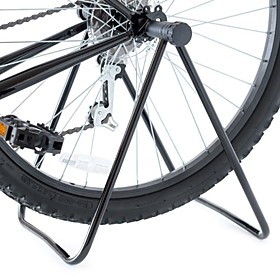
Quick-release wheels use a hollow hub axle fitted with a shaft, a lever that operates a cam mechanism, and an adjusting nut. Reposition the lever as necessary if it will not fully close. Position the rear lever so it falls between the chain stay and seat stays. Rotate front lever and adjusting nut so the lever will end up just in front of fork.


The quick-release skewer must be fully engaged on the dropout surfaces.
BICYCLE STANDS WITH REAR WHEEL OFF INSTALL
It is often easiest to install the front wheel when the bike is standing on the ground. Lubricate the axle threads while the wheel is off the bike. If the washer has teeth or knurling, these face the dropout to help secure the wheel. The axle nut will have a washer built into the nut, or a separate washer. Solid axle hubs use axle nuts outside the dropouts. If the wheel is not securely mounted in the dropouts, it may come out when the bike is ridden, possibly causing injury to the rider. Misalignment can result in problems with shifting and bike handling. The wheels must be properly mounted to the bicycle frame. For Shimano clutch derailleurs, look for the on/off lever, and move the it to the off position.For SRAM clutch derailleurs, move the lower pulley forward to relax the chain, and use the button to lock it in place.These come with features to help remove the wheel easily. Some derailleurs have a clutch mechanism that make it difficult to pivot the derailleur. Pivot rear derailleur back to clear wheel and cogs from frame Lower the wheel, guiding the wheel down through the brake pads and forward to clear the chain and derailleur.

For rear wheels, pull back on the rear derailleur to allow the cogs to clear the chain. On a front wheel, simply guide the wheel down and out of the fork.Solid Axle: For wheels with axle nuts, loosen both nuts outside of dropouts.Still others are simple levers that turn to loosen or tighten - no engagement or disengagement is necessary. Some thru axles are equipped with a special fitting that must be engaged to loosen the axle. Thru Axle: some function similarly to quick-release axle - pull lever outward to disengage and turn to loosen.If necessary, loosen quick-release adjusting nut to clear any tabs at end of fork. Quick Release: pull outward on end of quick-release skewer lever.Use a purpose-built pad spreader such as the Park Tool PP-1.2 if this happens. Otherwise, the pads will close and you will have a very difficult time getting the wheel back on the bike. Additionally, with hydraulic disc brakes, do not squeeze the brake lever when the disc is out of the bike. NOTE: With disc brakes, no pad disengagement is necessary. Squeeze cantilever calipers together and disconnect straddle wire cable Squeeze linear-pull calipers together and disconnect cable "noodle" from linkage


 0 kommentar(er)
0 kommentar(er)
